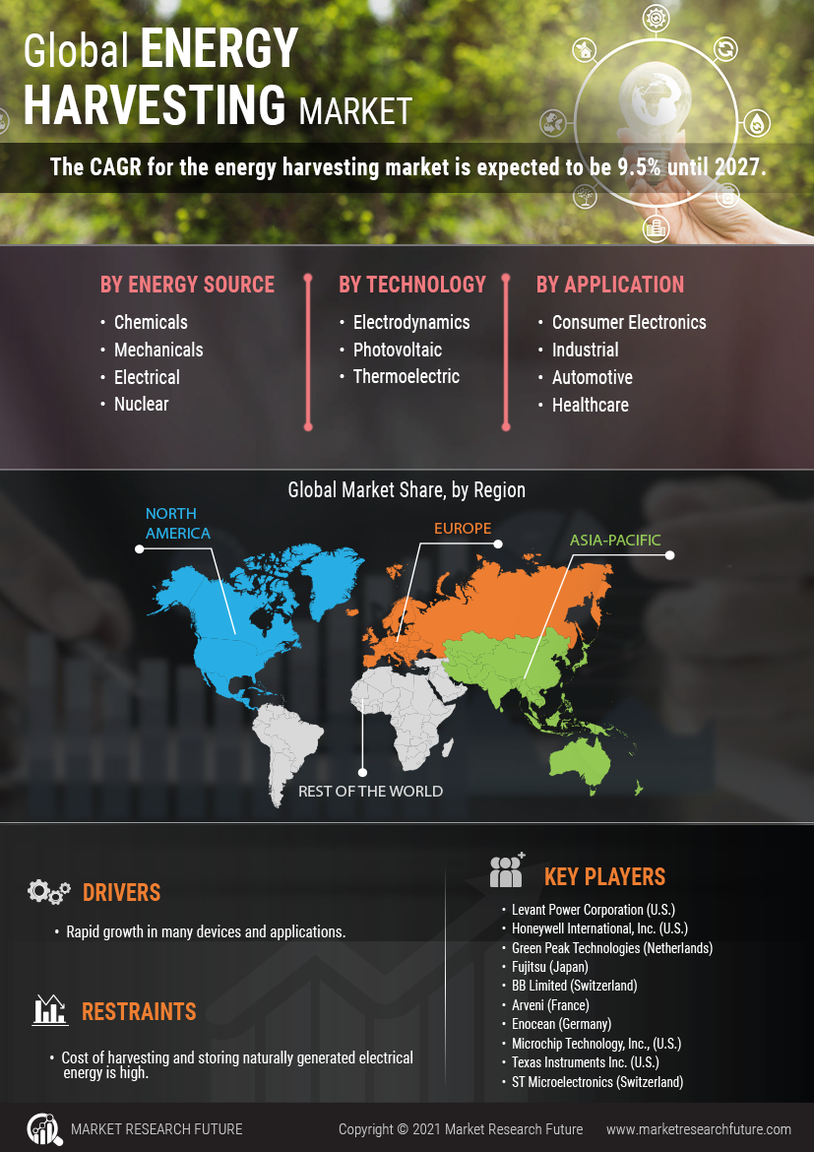Government Regulations and Incentives
Government regulations and incentives are playing a crucial role in the expansion of the Energy Harvesting Market. Many governments are implementing policies that promote renewable energy technologies, including energy harvesting solutions. These initiatives often include tax credits, grants, and subsidies aimed at encouraging businesses to adopt sustainable practices. For example, certain regions have introduced mandates requiring a percentage of energy to be sourced from renewable technologies, which directly benefits the energy harvesting sector. As these regulations become more stringent, companies are likely to invest more in energy harvesting technologies to comply with legal requirements. This trend suggests a robust future for the Energy Harvesting Market, as regulatory frameworks continue to evolve in favor of sustainable energy solutions.
Rising Demand for Sustainable Energy Solutions
The Energy Harvesting Market is experiencing a notable surge in demand for sustainable energy solutions. As environmental concerns intensify, industries are increasingly seeking alternatives to traditional energy sources. This shift is evidenced by a projected growth rate of approximately 15% annually in the energy harvesting sector. Companies are investing in technologies that harness energy from ambient sources, such as solar, thermal, and kinetic energy. This trend not only aligns with global sustainability goals but also enhances energy efficiency in various applications, from consumer electronics to industrial systems. The growing emphasis on reducing carbon footprints is likely to propel the Energy Harvesting Market further, as organizations strive to meet regulatory requirements and consumer expectations for greener practices.
Technological Innovations in Energy Harvesting
Technological advancements play a pivotal role in shaping the Energy Harvesting Market. Innovations in energy conversion technologies, such as piezoelectric materials and thermoelectric generators, are enhancing the efficiency and effectiveness of energy harvesting systems. For instance, recent developments have led to the creation of devices that can convert even minimal energy from vibrations or temperature differences into usable power. This has opened new avenues for applications in remote sensors and wearable devices, where traditional power sources are impractical. The market is projected to reach a valuation of USD 1.5 billion by 2026, driven by these technological breakthroughs. As research continues to evolve, the Energy Harvesting Market is likely to witness further enhancements in performance and cost-effectiveness.
Increasing Adoption of Wireless Sensor Networks
The proliferation of wireless sensor networks is significantly influencing the Energy Harvesting Market. These networks, which are integral to smart cities and industrial automation, require reliable and sustainable power sources. Energy harvesting technologies provide a viable solution, enabling sensors to operate without the need for battery replacements. This not only reduces maintenance costs but also enhances the longevity of sensor systems. The market for wireless sensor networks is expected to grow at a compound annual growth rate of 20% over the next five years, further driving the demand for energy harvesting solutions. As industries increasingly adopt these networks, the Energy Harvesting Market is poised for substantial growth, catering to the need for efficient and sustainable energy solutions.
Growing Consumer Awareness and Demand for Energy Efficiency
Consumer awareness regarding energy efficiency is increasingly influencing the Energy Harvesting Market. As individuals become more conscious of their energy consumption and its environmental impact, there is a growing demand for products that utilize energy harvesting technologies. This shift is evident in the consumer electronics sector, where devices that incorporate energy harvesting features are gaining popularity. Market Research Future indicates that products designed with energy efficiency in mind are expected to capture a larger market share, potentially reaching USD 500 million by 2025. This trend reflects a broader societal movement towards sustainability, compelling manufacturers to innovate and integrate energy harvesting solutions into their offerings. Consequently, the Energy Harvesting Market is likely to benefit from this heightened consumer interest in energy-efficient products.

















